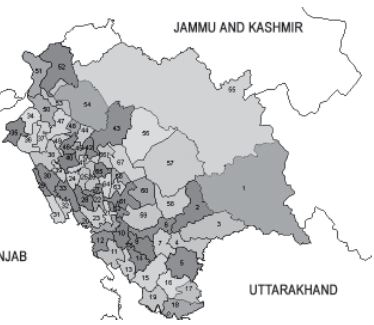How the State Government Works - Worksheets
CBSE Work Sheet 01
How the State Government Works
What is seen in the map below, showing division of which state

Kashmir
Uttarakhand
Punjab
Himachal Pradesh
- BJP stands for
- Bharatiya Jan Party
- Bharatiya Janata Party
- Bharatiya Jana Politician
- Bharatiya Jata Politician
- A gathering of journalist from the media who are invited to hear about and ask question on a particular issue and are then expected to report o this large public
- Journalist Meeting
- Press Conference
- Journalist Conference
- Press Meeting
- How many MLAs are required to form the government in a state
- All MLAs are required
- Less than half of the MLAs
- More than half of MLAS
- Half of the total MLAs
- Three levels of government in India are
- Central, State, Urban
- Central, State, Local
- Central, National, State
- Central, Rural, Urban
- Fill in the blanks:
All the MLAs who gather together in the Legislative Assembly are called __________.
- Fill in the blanks:
________ is the other name for Legislative Assembly.
- State true or false:
Rally is a method of protest against faulty government policies.
What do you know about a wallpaper?
Whose responsibility is it to run various government departments or ministers?
We live in a society in which all children face pressures from the world around them. Discuss.
Differentiate between Bye-elections and Midterm elections.
Explain with the example of Himachal Pradesh, the working of a State Legislative Assembly.
CBSE Work Sheet 01
How the State Government Works
Solution
- (d) Himachal Pradesh
Explanation: It can be seen that the Legislative Assembly of the state of Himachal Pradesh has 68 MLA constituencies - (b) Bharatiya Janata Party
Explanation: The Bharatiya Janata Party-BJP is one of the two major political parties in India - (b) Press Conference
Explanation: Press Conference: A gathering of journalists from the media who are invited to hear about and ask questions on a particular issue and are then expected to report on this to the larger public. - (c) More than half of MLAS
Explanation: A political party whose MLAs havewon more than half the number of constituencies in a state can be said to be in a majority.The political party that has the majority is called the ruling party and forms government.
- (b) Central, State, Local
Explanation: India has three levels of government that are:- 1. National(Center) Level 2. State Level 3. Local Level - Legislators
- Vidhan Sabha
True
A wallpaper is an interesting activity through which research can be done on particular topics of interest.
- It is the responsibility of the Chief Minister and other ministers to run various government departments or ministers.
Children face pressures from the world around them in the form of demands from adults. Sometimes they are teased by their friends. Boys are pressurized to get a job that will pay a good salary and sometimes when they do not behave properly they are being teased and bullied.
Bye-Elections Mid-Term Elections If in any case member of parliament, state legislative assembly dies or regines from his constituency before the completion of the tenure of the house, the election which takes place is known as Bye-elections. Sometimes the President dissolves the Lok Sabha on the advise of the Prime Minister before its completion, the tenure of 5 years in order to hold fresh elections to constitute new Lok Sabha. The election, thus so held is known as Mid-term elections. Himachal Pradesh is divided into 68 assembly constituencies. From each constituency, people elect one representative who then becomes a member of the Legislative Assembly. From 68 constituencies, a party needs more than 34 MLAs in order to gain the majority. In 2003, the Indian National Congress had a majority with 43 MLAs and became the ruling party. The MLAs other than Indian National Congress became opposition and it was Bharatiya Janata Party who had the second largest number of MLAs. Shri Virbhadra Singh was selected as the majority leader and became Chief Minister of Himachal Pradesh.
